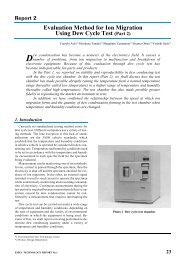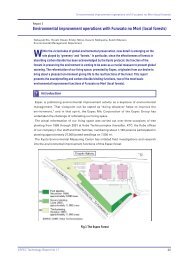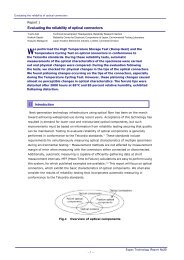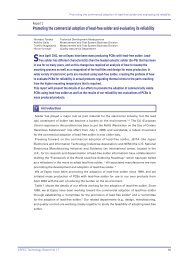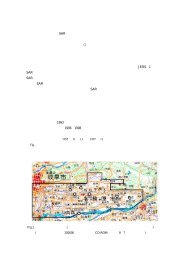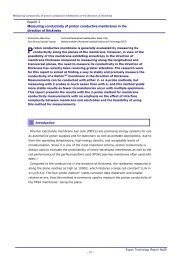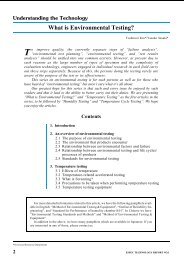Download
Download
Download
Create successful ePaper yourself
Turn your PDF publications into a flip-book with our unique Google optimized e-Paper software.
Understanding the Technology<br />
Fundamentals of Environmental Testing Standards<br />
Ayumi Ikeda*<br />
Certification systems are a current hot topic within the field of quality control, and<br />
such systems are increasingly being discussed within the context of standards. To<br />
keep readers up-to-date in this area, we are presenting an overview of the fundamentals<br />
of standards for environmental testing, an area that is central to quality control activity<br />
in the field of electricity and electronics.<br />
1. Standardization<br />
We all practice standardization in our everyday<br />
activities. For example, the center line on the highway<br />
does not mean, “Drive on whichever side of the road you<br />
please!” In Japan, driving on the left is standard, making<br />
for a safe and smooth flow of traffic. It seems like an<br />
obvious convention, but it is also an extremely important<br />
one for an automotive society such as ours.<br />
While standardization can also be seen as imposing<br />
restrictions, having everyone follow the same rules plays<br />
a crucial role in providing the ability to carry on troublefree<br />
routines in our daily lives.<br />
The original attempt to create an international standard<br />
was the “Metric Convention,” issued in 1875. This<br />
convention constituted an effort to define an international<br />
standard for the unit of measure, and the major<br />
contribution of that standard to the development of<br />
technology and industry is well known today.<br />
That original initiative brought a keen awareness<br />
among the nations of the need for international standards,<br />
leading to the establishment of the International<br />
Electrotechnical Commission (IEC) in 1908 and the<br />
International Organization for Standardization (ISO) in<br />
1947. At present, the IEC and ISO are central to a major<br />
trend of standardization for all kinds of industrial<br />
products.<br />
2. Environmental testing standards<br />
The standardization process referred to in section 1<br />
yields common rules called “standards.” These standards<br />
range from the in-house variety imposed by a company all<br />
the way up to the international standards agreed upon<br />
throughout the world. The industrial standards commonly<br />
used in Japan are the Japanese Industrial Standards, better<br />
known as JIS.<br />
In JIS, the term “standards” is defined as follows.<br />
“In order to transmit benefits and convenience fairly<br />
between related individuals with a unified and simple<br />
purpose, [standards are] specified agreements on technical<br />
matters directly or indirectly related to goods and services<br />
for specified agreements in such matters as goods,<br />
performance, capacity, configuration, status, operation,<br />
*Strategic Planning Department<br />
sequence, methods, procedures, responsibilities, duties,<br />
competence, methods of approach, and concepts.”<br />
Standards play a vital role in the field of environmental<br />
testing as well. Investigating and setting all of the<br />
individual test conditions can be a daunting task for<br />
persons running the tests, and any inconsistencies in test<br />
methods and conditions from one tester or group of testers<br />
to the next could create real problems. For these reasons,<br />
unified standards are essential in such areas as test<br />
methods, test conditions, test equipment, and recording,<br />
measuring, and evaluating the tests. Standards covering<br />
these areas are collectively referred to as “environmental<br />
testing standards.”<br />
3. Aims and role of environmental<br />
testing standards<br />
3-1 Providing common yardsticks and<br />
assurances<br />
By standardizing such matters as safety, quality, test<br />
methods, equipment compatibility, and properties of<br />
materials, we are able to provide common yardsticks for<br />
making judgments. As a result, we not only eliminate<br />
wasted effort in investigations and in stages of<br />
performance, we are also able to provide mutual<br />
assurances.<br />
3-2 Providing yardsticks<br />
On our first attempt to run a test, or when trying to<br />
modify a test method, we really need some sort of<br />
yardstick for determining such matters as test sequences<br />
and test conditions. Even slight variances in conditions<br />
during environmental tests can have a major impact on<br />
test results, and so one problem in a field such as<br />
environmental testing is the real difficulty in achieving<br />
theoretical correspondence in test results. Such difficulties<br />
place a premium on experience in the area of<br />
environmental testing. In today’s atmosphere of intense<br />
corporate competition, experience also helps in the<br />
arduous task of obtaining information concerning tests<br />
run by competitors. Due to the limited amount of details<br />
available, environmental testing standards can provide a<br />
valuable yardstick for discerning the true meaning behind<br />
the announced results of testing by competitors.<br />
ESPEC TECHNOLOGY REPORT No. 12 1
3-3 Serving as a manual<br />
The standards do not merely determine test conditions<br />
and the method and sequence of the test. Standards also<br />
offer reference data, present techniques for running the<br />
test skillfully, and provide valuable information on<br />
organizing and judging test results.<br />
The atmospheric data recorded in the US military<br />
standard MIL-STD-810, for example, is generally very<br />
difficult to obtain. In such cases, standards can be used as<br />
manuals.<br />
3-4 Providing a source of information on test<br />
trends<br />
Given the dizzying pace of today’s technical progress,<br />
standards rarely endure over long periods of years, instead<br />
being frequently revised in accord with current<br />
conditions. As has been mentioned, information is<br />
relatively scarce in the arena of environmental testing,<br />
and investigating test trends in this secretive atmosphere<br />
can be very time-consuming. However, the effort to<br />
obtain information concerning transitions or revisions of<br />
standards is a means of obtaining valuable information on<br />
recent technological trends in testing, and should not be<br />
neglected.<br />
4. Classification of standards<br />
Various methods are used to classify standards.<br />
Classification can be made according to the organizations<br />
managing the standards, it can be made according to the<br />
items to which the standards are applied, or it can be<br />
made according to the purpose of the standards. More<br />
classification methods exist than can be enumerated. Let’s<br />
look at some examples of classification.<br />
2<br />
(a) Classification according to the organization managing<br />
the standard — Refer to Table 1.<br />
(b) Classification according to the items to which the<br />
standards are applied<br />
[Example of plastics]<br />
ISO 178 Plastics-Determination of flexural<br />
properties<br />
ISO 4892-1 Plastics-Methods of exposure to<br />
laboratory light sources-Part 1: General<br />
guidance<br />
JIS K 6900 Plastics-Vocabulary<br />
(c) Classification according to purpose<br />
[Example of temperature tests]<br />
IEC 60068-2-2 Environmental testing.<br />
Part 2: Tests. Test B: Dry heat<br />
MIL-STD-810 Method 501 High temperature<br />
Below are examples of classification based on the<br />
managing organizations (Table 1). These can be broadly<br />
divided into international standards, regional standards,<br />
national standards, and group standards.<br />
5. Overview of major environmental<br />
testing standards<br />
5-1 IEC (International Electrotechnical<br />
Commission)<br />
The IEC sets standards in the field of electricity and<br />
electronics, and is headquartered in Geneva, Switzerland.<br />
Currently, as of November 2000, the group counts 61<br />
member nations, including Japan. Since the IEC standards<br />
cannot issue standards without international agreement,<br />
the contents of the standards reflect concessions to the<br />
circumstances of various countries.<br />
Table 1 Classification of standards (Classification by managing organizations)<br />
Classification Major standards<br />
International standards<br />
Standards created through international<br />
cooperation for the mutual benefit of various<br />
countries and employed throughout the world.<br />
Regional Standards<br />
Standards established and applied within the<br />
limits of a specific region.<br />
National standards<br />
Domestic standards established by authorized<br />
agencies and created through mutual agreement<br />
of various interested parties of that country.<br />
Organizational Standards<br />
Institutes and industrial organizations handle<br />
standardization as one of their activities.<br />
Standards are created by agreement among the<br />
members, and so as a rule are used within the<br />
organization, or to facilitate their dealings and<br />
transactions.<br />
ISO (International Organization for Standardization)<br />
Responsible for standardization in fields other than electricity and electronics.<br />
Examples include the ISO 9000 Series (quality management systems) and the<br />
ISO 14000 Series (environmental management systems).<br />
IEC (International Electrotechnical Commission)<br />
Responsible for standardization in the fields of electricity and electronics.<br />
EN (European Unified Standards)<br />
Unified standards set by the CEN (The European Committee for<br />
Standardization) and CENELEC(European Committee For Electrotechnical<br />
Standardization)<br />
Japan<br />
USA<br />
Britain<br />
Germany<br />
China<br />
Japan<br />
USA<br />
JIS (Japan Industrial Standards)<br />
ANSI (American National Standards)<br />
BS (British Standard)<br />
DIN (Deutsche Institute für Normung)<br />
GB (Guojia Biaozhum)<br />
JASO (Japan Automobile Standards Organization)<br />
EIAJ (Japan Electronics and Information Technology Industries<br />
Association)<br />
JTM (Testing Machinery Association of Japan)<br />
MIL (US Military Standards) and so on<br />
ESPEC TECHNOLOGY REPORT No. 12
5-1-1 How to read IEC standard ID numbers<br />
IEC 60068-3-1 A<br />
(1) (2) (3)<br />
(1) Number of the standard (not particularly classified,<br />
numbers are determined by the order in which the<br />
standards are enacted)<br />
(2) Section and sub-section (none, when there is no<br />
section or sub-section)<br />
(3) Supplement (alphabetic character)<br />
5-1-2 Revisions<br />
In principle, IEC standards are deliberated every five<br />
years, and can either be “confirmed” (deliberations find<br />
contents appropriate to current circumstances, and they<br />
are left unchanged), “amended” or “abolished.” When a<br />
section of text is amended, the details are issued as an<br />
“amendment.” Such amendments are issued as No.1,<br />
No.2, etc. in the order in which each amendment was<br />
made. Therefore, when investigating a standard, one must<br />
also check for amendments.<br />
[Example]<br />
IEC60068-2-1 (issued in 1990) 43 pages<br />
Amendment No.1 (issued in 1993) 3 pages<br />
Amendment No.2 (issued in 1994) 7 pages<br />
Accordingly, the most recent edition of IEC60068-2-1<br />
consists of all three of these documents.<br />
5-1-3 Environmental Tests<br />
Series 60068 (environmental tests) is used most often.<br />
The 60068 series was deliberated and enacted by IEC<br />
Technical Committee TC104 (environmental conditions,<br />
classification and test methods). (Refer to Table 2.)<br />
No. (Publication date)<br />
Table 2 The IEC60068 Series and corresponding JIS numbers<br />
Title<br />
JIS<br />
60068-1(1998)<br />
General and guidance<br />
C-0010*<br />
60068-1-am1(1992) Amendment No.1<br />
60068-2-1(1990) Cold<br />
C-0020<br />
60068-2-1-am1(1993) Amendment No.1<br />
60068-2-1-am2(1994) Amendment No.2<br />
60068-2-2(1974) Dry heat<br />
C-0021<br />
60068-2-2-am1(1993) Amendment No.1<br />
60068-2-2-am2(1994) Amendment No.2<br />
60068-2-3(1969) Damp heat, steady state<br />
60068-2-5(1975) Simulated solar radiation at ground level<br />
60068-2-6(1995) Vibration (sinusoidal)<br />
C-0040<br />
60068-2-7(1983) Acceleration, steady state<br />
C-0045<br />
60068-2-7-am1(1986) Amendment No.1<br />
60068-2-9(1975) Guidance for solar radiation testing<br />
60068-2-9-am1(1984) Amendment No.1<br />
60068-2-10(1988) Mould growth<br />
60068-2-11(1981) Salt mist<br />
C-0023<br />
60068-2-13(1983) Low air pressure<br />
C-0029<br />
60068-2-14(1984) Change of temperature<br />
C-0025<br />
60068-2-14-am1(1986) Amendment No.1<br />
60068-2-17(1994) Sealing<br />
C-0026*<br />
60068-2-18(2000) Water<br />
C-0034<br />
60068-2-20(1979) Soldering<br />
C-0050<br />
60068-2-20-am2(1987) Amendment No.2<br />
60068-2-21(1999) Robustness of terminations and integral mounting devices<br />
C-0051*<br />
60068-2-27(1987) Shock<br />
C-0041*<br />
60068-2-28(1990) Guidance for damp heat tests<br />
C-0033<br />
60068-2-29(1987) Bump<br />
C-0042<br />
60068-2-30(1980) Damp heat, cyclic (12 +12-hour cycle)<br />
C-0027<br />
60068-2-30-am1(1985) Amendment No.1<br />
60068-2-31(1969) Drop and topple, primarily for equipment-type specimens<br />
C-0043<br />
60068-2-31-am1(1982) Amendment No.1<br />
60068-2-32(1975) Free fall (Procedure 1)<br />
C-0044<br />
60068-2-32-am2(1990) Amendment No.2<br />
60068-2-33(1971) Guidance on change of temperature tests<br />
60068-2-33-am1(1978) Amendment No.1<br />
(Cont.)<br />
ESPEC TECHNOLOGY REPORT No. 12 3
(Cont. from the previous page)<br />
60068-2-38(1974) Composite temperature/humidity cyclic test<br />
60068-2-39(1976) Combined sequential cold, low air pressure, and damp heat test<br />
60068-2-40(1976) Combined cold/low air pressure tests<br />
60068-2-40-am1(1983) Amendment No.1<br />
60068-2-41(1976) Combined dry heat/low air pressure tests<br />
60068-2-41-am1(1983) Amendment No.1<br />
60068-2-42(1982) Sulphur dioxide test for contacts and connections<br />
60068-2-43(1976) Hydrogen sulphide test for contacts and connections<br />
60068-2-44(1995) Guidance on Test T: Soldering<br />
60068-2-45(1980) Immersion in cleaning solvents<br />
60068-2-45-am1(1993) Amendment No.1<br />
60068-2-46(1982) Hydrogen sulphide test for contacts and connections<br />
60068-2-47(1999) Mounting of components, equipment and other articles for vibration, impact and similar<br />
dynamic tests<br />
60068-2-48(1982) Guidance on the application of the tests of IEC 68 to simulate the effects of storage<br />
60068-2-49(1983) Guidance on Test Kc: Sulphur dioxide test for contacts and connections<br />
60068-2-50(1983) Combined cold/vibration (sinusoidal) tests for both heat-dissipating and non-heat-dissipating<br />
specimens<br />
60068-2-51(1983) Combined dry heat/vibration (sinusoidal) tests for both heat-dissipating and non-heatdissipating<br />
specimens<br />
60068-2-52(1996) Salt mist, cyclic (sodium, chloride solution)<br />
60068-2-53(1984) Guidance to Tests Z/Afc and Z/BFc: Combined temperature(cold and dry heat) and vibration<br />
(sinusoidal) tests<br />
60068-2-54(1985) Soldering-Solderability testing by the wetting balance method<br />
60068-2-55(1987) Bounce<br />
60068-2-56(1988) Damp heat, steady state, primarily for equipment<br />
60068-2-57(1999) Vibration-Time-history method<br />
60068-2-58(1999) Test methods for solderability, resistance to dissolution of metallization and to soldering heat<br />
of surface mounting devices (SMD)<br />
60068-2-59(1990) Vibration-Sine-beat method<br />
60068-2-60(1995) Flowing mixed gas corrosion test<br />
60068-2-61(1991) Climatic sequence<br />
60068-2-64(1993) Vibration, broad-band random (digital control) and guidance<br />
60068-2-65(1993) Vibration, acoustically induced<br />
60068-2-66(1994) Damp heat, steady state (unsaturated pressurized vapour)<br />
60068-2-67(1995) Damp heat, steady state, accelerated test primarily intended for components<br />
60068-2-68(1994) Dust and sand<br />
60068-2-69(1995) Solderability testing of electronic components for surface mount technology by the wetting<br />
balance method<br />
60068-2-70(1995) Abrasion of marking and letterings caused by rubbing of fingers and hands<br />
60068-2-74(1999) Fluid contamination<br />
60068-2-75(1997) Hammer tests<br />
60068-2-77(1999) Body strength and impact shock<br />
60068-3-1(1974) Background information-Section One: Cold and dry heat tests<br />
60068-3-1A(1978) First supplement<br />
60068-3-2(1976) Background information-Combined temperature/low air pressure tests<br />
60068-3-3(1991) Guidance-Seismic test methods for equipment<br />
60068-4(1987)<br />
Informational for specification writers-Test summaries<br />
60068-4-am1(1992) Amendment No.1<br />
60068-4-am2(1994) Amendment No.2<br />
60068-5-1(1991) Guide to drafting of test methods. General principles<br />
60068-5-2(1992) Guide to drafting of test methods-Terms and definitions<br />
4<br />
C-0028<br />
C-0030<br />
C-0031<br />
C-0090<br />
C-0092<br />
C-0052<br />
C-0093<br />
C-0047*<br />
C-0091<br />
C-0038<br />
C-0037<br />
C-0024<br />
C-0039<br />
C-0053<br />
C-0032<br />
C-0054*<br />
C-0048<br />
C-0035<br />
C-0036<br />
C-0095<br />
C-0055<br />
* These correspond to the IEC numbers, but correspondences are only shown for old editions.<br />
ESPEC TECHNOLOGY REPORT No. 12
5-2 JIS (Japan Industrial Standards)<br />
JIS sets standards for industrial products through<br />
industrial standardization laws aimed at improving<br />
quality. The Ministry of Economy, Trade and Industry<br />
enacts the standards based on investigations by the<br />
Japanese Industrial Standards Committee. As of March<br />
2000, 8,768 JIS standards have been enacted.<br />
To promote international coordination of standards,<br />
many currently enacted JIS standards are direct<br />
translations of ISO and IEC standards. As a result, JIS<br />
standards now are issued using a system of section and<br />
sub-section numbers and supplements that were not used<br />
in earlier JIS standards.<br />
5-2-1 How to read JIS standard ID numbers<br />
The JIS number is composed of an alphabetic character<br />
used as a department symbol, and a classification number.<br />
JIS C 0010- 1993<br />
(1) (2) (3)<br />
(1) The number of the department (C stands for<br />
electronic equipment and electrical machinery.)<br />
(2) The number of the standard (The first two digits on<br />
the left represent the classification. For C, 00 through<br />
09 represent general classification.)<br />
(3) The calendar year of the enactment or revision<br />
5-2-2 Revision<br />
In principle, JIS standards are deliberated every five<br />
years, and can either be “confirmed,” “revised” or<br />
“abolished.” To help you keep abreast of new<br />
developments in this area, the Japanese Standards<br />
Association publishes its official monthly magazine called<br />
The Standardization Journal, and you can also find<br />
information on the Japanese Standards Association<br />
homepage at http://www.jsa.or.jp/.<br />
5-2-3 Environmental test standards<br />
A number of environmental test methods are<br />
established in JIS, but the most common series for the<br />
electrical and electronics field is the C0010 series, almost<br />
all of which has been adopted from the aforementioned<br />
IEC60068 series. (However, the details of some standards<br />
have been modified to conform to the actual circumstances<br />
in Japan.) (Refer to Tables 3 and 4.)<br />
Table 3 JIS C0010 Series (Environmental testing)<br />
No. Title<br />
C0010:93 General and guidance<br />
C0020:95 Cold<br />
C0021:95 Dry heat<br />
C0022:87 Damp heat, steady state<br />
C0023:89 Salt mist<br />
C0024:00 Salt mist, cyclic (sodium, chloride solution)<br />
C0025:88 Change of temperature<br />
C0026:94 Sealing<br />
C0027:88 Damp heat, cyclic (12 +12-hour cycle)<br />
C0028:88 Composite temperature/humidity cyclic test<br />
C0029:89 Low air pressure<br />
C0030:95 Combined cold/low air pressure tests<br />
C0031:95 Combined dry heat/low air pressure tests<br />
C0032:96 Damp heat, steady state, primarily for equipment<br />
C0033:93 Guidance for damp heat tests<br />
C0034:96 Water<br />
C0035:96 Climatic sequence<br />
C0036:97 Vibration, broad-band randam (digital control)<br />
and guidance<br />
C0037:97 Combined dry heat/vibration (sinusoidal) tests<br />
for both heat-dissipating and non-heatdissipating<br />
specimens<br />
C0038:97 Combined cold/vibration (sinusoidal) tests for<br />
both heat-dissipating and non-heat-dissipating<br />
specimens<br />
C0039:97 Guidance to Tests Z/Afc and Z/BFc: Combined<br />
temperature(cold and dry heat) and vibration<br />
(sinusoidal) tests<br />
C0040:99 Vibration (sinusoidal)<br />
C0041:95 Shock<br />
C0042:95 Bump<br />
C0043:95 Drop and topple, primarily for equipment-type<br />
specimens<br />
C0044:95 Free fall (Procedure 1)<br />
C0045:93 Acceleration, steady state<br />
C0046:93 Impact, spring hammer<br />
C0047:95 Mounting of components, equipment and other<br />
articles for dynamic tests including shock (Ea),<br />
bump (Ed), vibration (Fc and Fd) and steadystate<br />
acceleration (Ga) and guidance<br />
C0048:99 Flowing mixed gas corrosion test<br />
C0050:96 Soldering<br />
C0051:94 Robustness of terminations and integral<br />
mounting devices<br />
C0052:95 Immersion in cleaning solvents<br />
C0053:96 Solderability testing by the wetting balance<br />
method<br />
C0054:94 Solderability, resistance to dissolution of<br />
metallization and to soldering heat of surface<br />
mounting devices (SMD)<br />
C0055:00 Guidance. Seismic test method for equipments<br />
C0061:00 Fire hazard testing - Needle-flame test<br />
C0062:87 Fire hazard testing - bad-connection test with<br />
heaters<br />
(Cont.)<br />
ESPEC TECHNOLOGY REPORT No. 12 5
(Cont. from the previous page)<br />
6<br />
C0063:00<br />
C0064:93<br />
C0065:93<br />
C0066:93<br />
C0067:99<br />
C0068:95<br />
C0069:95<br />
C0070:96<br />
C0071:97<br />
C0072:97<br />
C0073:97<br />
C0074:97<br />
C0075:97<br />
C0076:97<br />
C0077:99<br />
C0078:00<br />
C0090:93<br />
C0091:93<br />
C0092:93<br />
C0093:93<br />
C0094:93<br />
C0095:95<br />
Fire hazard testing - Guidance for assessing fire<br />
hazard of electrotechnical products—General<br />
guidance<br />
Fire hazard testing. Part 1: Guidance for the<br />
preparation of requirements and test<br />
specifications for assessing fire hazard of<br />
electerotechnical products: guidance for<br />
electronic components<br />
Fire hazard testing. Part 1: Guidance for the<br />
preparation of requirements and test<br />
specifications for assessing fire hazard of<br />
electrotechnical products: Guidance for use<br />
preselection procedures<br />
Methods of test for the determination of the<br />
flammablity of solid electrical insulating<br />
materials when exposed to an igniting source<br />
Terminology concerning fire test<br />
Fire hazard testing - Diffusion type and<br />
premixed type flame test methods<br />
Fire hazard testing - 1 kW nominal pre-mixed<br />
test flame and guidance<br />
Fire hazard testing. Assessment of potential<br />
corrosion damage by fire effluent—General<br />
guidance<br />
Fire hazard testing - 500 W nominal test flames<br />
and guidance<br />
Fire hazard testing - Glow-wire test methods—<br />
General<br />
Fire hazard testing - Glow-wire end-product test<br />
and guidance<br />
Fire hazard testing - Glow-wire flammability test<br />
on materials<br />
Fire hazard testing - Glow-wire ignitability test<br />
on materials<br />
Fire hazard testing. Guidance on the<br />
minimization of toxic hazards due to fires<br />
involving electrotechnical products—General<br />
Fire hazard testing - Assessment of potential<br />
corrosion damage by fire effluent—Guidance on<br />
the selection and use of test methods<br />
Fire hazard testing. Guidance and test methods<br />
for the minimization of the effects of abnormal<br />
heat on electrotechnical products involved in<br />
fires-Method for testing products made from<br />
non-metallic materials for resistance to heat<br />
using the ball pressure test<br />
Sulphur dioxide test for contacts and<br />
connections<br />
Guidance on Test Kc: Sulphur dioxide test for<br />
contacts and connections<br />
Hydrogen sulphide test for contacts and<br />
connections<br />
Guidance on Test Kd: Hydrogen sulphide test<br />
for contacts and connections<br />
An appraisal of the problems of accelerated<br />
testing for atmospheric corrosion<br />
Background information—Cold and dry heat<br />
tests<br />
Table 4 JIS C0010 Series (Classification of<br />
environmental conditions)<br />
No. Title<br />
C0110:95 Classification of environmental parameters and<br />
their severities<br />
C0111:95 Environmental conditions appearing in nature.<br />
Temperature and humidity<br />
C0112:95 Classification of groups of environmental<br />
parameters and their severities introduction<br />
C0113:96 Environmental conditions appearing in nature.<br />
Precipitation and wind<br />
C0114:97 Classification of groups of environmental<br />
parameters and their severities—Storage<br />
C0115:97 Environmental conditions appearing in nature.<br />
Air pressure<br />
C0116:97 Classification of groups of environmental<br />
parameters and their severities—Stationary use<br />
at weatherprotected locations<br />
C0117:97 Classification of groups of environmental<br />
parameters and their severities—Stationary use<br />
at non-weatherprotected locations<br />
C0118:99 Environmental conditions appearing in nature.<br />
Solar radiation and temperature<br />
C0119:99 Classification of groups of environmental<br />
parameters and their severities. Portable and<br />
non-stationary use<br />
C0120:00 Classification of groups of environmental<br />
parameters and their severities. Microclimates<br />
inside products<br />
5-3 MIL (US military standards)<br />
MIL (Military Specifications and Military Standards)<br />
is a document used by the US Department of Defense.<br />
This document was drafted exclusively with regard to<br />
materials, products, and labor used by the federal<br />
government or military agencies.<br />
Features include: (1) revisions are made promptly<br />
when something is found to be amiss; (2) equipment and<br />
manufacturers are specified; and, (3) constant supervision<br />
is required due to frequent revisions.<br />
Since environmental tests were historically developed<br />
within the framework of military use, military standards<br />
have exerted a major influence on all types of<br />
environmental testing standards. Furthermore, it has<br />
become extremely common for these standards to be<br />
applied in fields outside the military.<br />
5-3-1 Organization<br />
The organization of the military standards is as<br />
follows.<br />
• Military Specifications<br />
Drafted for individual items<br />
• Military Standards<br />
Drafted to prescribe technical methods for standard<br />
items, and to explain such methods<br />
• Military Handbook<br />
Drafted to explain and provide a commentary on<br />
technological data for military specifications and<br />
military standards<br />
ESPEC TECHNOLOGY REPORT No. 12
5-3-2 How to read MIL standard ID numbers<br />
MIL-STD-883 E 1010.7<br />
(1) (2) (3) (4) (5)<br />
(1) Classification — The following abbreviations are<br />
used.<br />
SPEC: military specification<br />
STD: military standard<br />
HDBK: military handbook<br />
(2) Number of the standard<br />
(3) Alphabetic character indicating the revision<br />
(4) Number of the individual test method<br />
(5) Character indicating the individual test method<br />
revision. Depending on the standard number, this can<br />
be either an alphabetic character or a numeral.<br />
5-3-3 Revisions<br />
A standard generally does not have binding force on its<br />
own, and so merely abolishing an old standard does not<br />
prevent its use. In fact, care must be taken with MIL<br />
standards because old versions are often used. The<br />
following three types of revisions are used.<br />
(1) Amendment<br />
(2) Change Notice<br />
Small-scale revisions are merely issued on an<br />
alteration page. One must realize that details from<br />
previous Change Notices are not included. In this<br />
case, only the test number is revised. (Previous item<br />
(5))<br />
[Example] MIL-STD-883D 1010.6<br />
Example: →MIL-STD-883D 1010.7<br />
(3) Complete revision<br />
Large-scale revisions result in the entire standard<br />
being re-issued. In such cases, the alphabetic<br />
character at the end of the standard number is<br />
changed.<br />
[Example] MIL-STD-883D → MIL-STD-883E<br />
The three instances above are not decoded in the same<br />
way as the JIS standards. The only way to tell the new<br />
versions from the old ones is to compare the texts. Also,<br />
the test method may be revised as in (2) even when the<br />
entire standard is not re-issued as in (3), and so when<br />
investigating MIL standard test methods, you must<br />
confirm the test method number.<br />
5-3-4 Environmental test standards<br />
The following are some typical environmental testing<br />
standards.<br />
MIL-STD-202 Test Methods for Electronic and<br />
Electrical Component<br />
MIL-STD-750 Semiconductor Devices<br />
MIL-STD-810 Environmental Engineering<br />
Considerations and Laboratory Tests<br />
MIL-STD-883 Microcircuit<br />
Tables 5 through 8 show environmental test methods<br />
from within each of the standards.<br />
Table 5 MIL-STD-202F Test Methods for Electronic<br />
and Electrical Component Parts<br />
Class 100 (Environmental Tests)<br />
No. Title<br />
ESPEC TECHNOLOGY REPORT No. 12 7<br />
101<br />
102<br />
103<br />
104<br />
105<br />
106<br />
107<br />
108<br />
109<br />
110<br />
111<br />
112<br />
Salt spray (corrosion)<br />
Temperature cycling<br />
Humidity (steady state)<br />
Immersion<br />
Barometric pressure (reduced)<br />
Moisture resistance<br />
Thermal shock<br />
Life (At elevated ambient temperature)<br />
Explosion<br />
Sand and dust<br />
Flammability (external flame)<br />
Seal<br />
Table 6 MIL-STD-750D Semiconductor Devices<br />
1000 Class Environmental Tests<br />
Method Title<br />
1001 Barometric pressure (reduced)<br />
1011 Immersion<br />
1015 Steady-state primary photocurrent irradiation<br />
procedure (electron beam)<br />
1016 Insulation resistance<br />
1017 Neutron irradiation<br />
1018 Internal water-vapor content<br />
1019 Steady-state total dose irradiation procedure<br />
1020 Electrostatic discharge sensitivity (ESDS)<br />
classification<br />
1021 Moisture resistance<br />
1022 Resistance to solvents<br />
1026 Steady-state-operation life<br />
1027 Steady-state operation life (sample plan)<br />
1031 High-temperature life (nonoperating)<br />
1032 High-temperature (nonoperating) life (sample plan)<br />
1033 Reverse voltage leakage stability<br />
1036 Intermittent operation life<br />
1037 Intermittent operation life (sample plan)<br />
1038 Burn-in (for diodes, rectifiers, and zeners)<br />
1039 Burn-in (for transistors)<br />
1040 Burn-in (for thyristors (controlled rectifiers))<br />
1041 Salt atmosphere (corrosion)<br />
1042 Burn-in and life test for power MOSFET’s or<br />
insulated gate bipolar transistors (IGBT)<br />
1046 Salt spray (corrosion)<br />
1048 Blocking life<br />
1049 Blocking life (sample plan)<br />
1051 Temperature cycling (air to air)<br />
1054 Potted environment stress test<br />
1055 Monitored mission temperature cycle<br />
1056 Thermal shock (liquid to liquid)<br />
1061 Temperature measurement, case and stud<br />
1066 Dew point<br />
1071 Hermetic seal<br />
1080 Single event gate rupture and drain burnout test
Table 7 MIL-STD-810F Environmental Engineering<br />
Considerations and Laboratory Tests<br />
Laboratory Test Methods<br />
Table 8 MIL-STD-883E Microcircuit<br />
Environmental Tests<br />
Method Title<br />
1001 Barometric pressure, reduced (altitude operation)<br />
1002 Immersion<br />
1003 Insulation resistance<br />
1004 Moisture resistance<br />
1005 Steady state life<br />
1006 Intermittent life<br />
1007 Agree life<br />
1008 Stabilization bake<br />
1009 Salt atmosphere (corrosion)<br />
1010 Temperature cycling<br />
1011 Thermal shock<br />
1012 Thermal characteristics<br />
1013 Dew point<br />
1014 Seal<br />
1015 Burn-in test<br />
1016 Life/reliability characterization tests<br />
1017 Neutron irradiation<br />
1018 Internal water-vapor content<br />
1019 Ionizing radiation (total dose) test procedure<br />
1020 Dose rate induced latchup test procedure<br />
1021 Dose rate upset testing of digital microcircuits<br />
1022 Mosfet threshold voltage<br />
1023 Dose rate response of linear microcircuits<br />
8<br />
No. Title<br />
500 Low Pressure (Altitude)<br />
501 High Temperature<br />
502 Low Temperature<br />
503 Temperature Shock<br />
504 Contamination by Fluids<br />
505 Solar Radiation (Sunshine)<br />
506 Rain<br />
507 Humidity<br />
508 Fungus<br />
509 Salt Fog<br />
510 Sand and Dust<br />
511 Explosive Atmosphere<br />
512 Immersion<br />
513 Acceleration<br />
514 Vibration<br />
515 Acoustic Noise<br />
516 Shock<br />
517 Pyroshock<br />
518 Acidic Atmosphere<br />
519 Gunfire Vibration<br />
520 Temperature, Humidity, Vibration, and Altitude<br />
521 Icing/Freezing Rain<br />
522 Ballistic Shock<br />
523 Vibro—Acoustic/Temperature<br />
(Cont.)<br />
(Cont. from the previous column)<br />
1030 Preseal burn-in<br />
1031 Thin film corrosion test<br />
1032 Package induced soft error test procedure (due to<br />
alpha particles)<br />
1033 Endurance life test<br />
1034 Die penetrant test (for plastic devices)<br />
5-4 Standards of Japanese organizations<br />
5-4-1 JASO (Japanese Automobile Standards<br />
Organization)<br />
Automobile standards issued by the Japanese<br />
Automobile Standards Organization are generally referred<br />
to as “JASO standards.” The most commonly used<br />
standard for environmental tests is the “General Rules of<br />
Environmental Testing Methods for Automobile<br />
Electronic Equipment D001.” This standard sets 26 test<br />
methods for such environmental tests as the temperature<br />
and humidity cycle test, the low-temperature shelf test,<br />
and the dew cycle test. Table 9 shows test items from this<br />
standard.<br />
Table 9 JASO D001 General rules of environmental<br />
testing methods for automotive electronic<br />
equipments<br />
Method No. Title<br />
5.1 Normal power supply voltage test<br />
5.2 Test for power supply voltage upon engine<br />
starting<br />
5.3 Power source micro interruption test<br />
5.4 Power supply inverse polarity connection test<br />
5.5 Overvoltage test (A method)<br />
5.6 Overvoltage test (B method)<br />
5.7 Transient voltage characteristics test<br />
5.8 Electrostatic test<br />
5.9 Conducted electromagnetic test<br />
5.10 Radiated electromagnetic test<br />
5.11 Temperature characteristic test<br />
5.12 Low temperature maintain test<br />
5.13 Low temperature operation test<br />
5.14 High temperature maintain test<br />
5.15 High temperature operation test<br />
5.16 Heat cycle test<br />
5.17 Thermal shock test<br />
5.18 Temperature and humidity cycle test<br />
5.19 Constant high humidity test<br />
5.20 Dew formation test<br />
5.21 Water resistance test<br />
5.22 Salt water spray test<br />
5.23 Vibration test<br />
5.24 Shock resistance test<br />
5.25 Dust resistance test<br />
5.26 Oil resistance test<br />
* An English version of JASO D001 has been issued.<br />
ESPEC TECHNOLOGY REPORT No. 12
5-4-2 EIAJ (Electronic Industries Association of<br />
Japan, currently Japan Electronics and<br />
Information Technology Industries<br />
Association)<br />
The creation of the Japan Electronics and Information<br />
Technology Industries Association (JEITA) in November<br />
2000 resulted from a merger of the Japan Electronic<br />
Industry Development Association and the Electronic<br />
Industries Association of Japan. Existing standards from<br />
the old organizations were transferred unchanged to the<br />
new organization. In other words, standards from the<br />
Electronic Industries Association of Japan, known as<br />
“EIAJ standards,” continue to exist and are still called<br />
“EIAJ standards.” Standards are issued for each<br />
individual environmental test. Table 10 presents some<br />
examples of EIAJ environmental testing standards.<br />
Table 10 EIAJ standards for environmental test<br />
methods<br />
No. Title<br />
CP-5102 Methods of measurement on receiving antennas<br />
for SHF satellite broadcast transmission<br />
(mechanical and environmental characteristics)<br />
ED-2531 Environmental test methods for Liquid Crystal<br />
Display devices<br />
ED-4701* Environmental and endurance test methods for<br />
semiconductor devices<br />
ED-8403 Environmental and endurance test methods for<br />
semiconductor pressure sensors (diffused<br />
piezoresistance type)<br />
ED-8503 Environmental and endurance test methods for<br />
mini-mold type hall sensors<br />
ET-7407* Environmental and endurance test methods for<br />
CSP/BGA package on mounting condition<br />
RC-8325 Testing methods for environmental test of audio<br />
magnetic heads<br />
* English versions have been issued for standards marked with<br />
an asterisk.<br />
5-4-3 JTM (Testing Machinery Association of Japan)<br />
The standards issued by the Testing Machinery<br />
Association of Japan differ from those we have been<br />
discussing up to this point. Rather than addressing<br />
environmental test methods, these standards are set for the<br />
test equipment. Tabai is a member of this association, and<br />
participates in issuing the standards. Table 11 presents<br />
some examples of JTM standards.<br />
No. Title<br />
JTM K-01:1998 Humidity chambers—Test and indication<br />
method for performance<br />
JTM K-02-1999 Standard for safety of humidity chambers<br />
JTM K-03-1992 Standard for performance of environmental<br />
temperature and humidity rooms<br />
JTM K-04:1992 Standard for safety of environmental<br />
temperature and humidity rooms<br />
JTM K-05:2000 High temperature chambers—Test and<br />
indication method for performance<br />
JTM K-06: 2001 Standard for safety of high temperature<br />
chambers<br />
6. Supplement<br />
Table 11 JTM standard<br />
This report has presented a brief overview of<br />
environmental testing standards to provide an aid to<br />
understanding the basics of those standards. While the<br />
examples given are typical, they cannot provide a<br />
thorough treatment of the subject. Please realize also that<br />
the test methods presented in the tables cannot cover<br />
every aspect.<br />
As has been noted, obtaining information about<br />
standards requires knowledge of trends in test technology,<br />
and so one must be vigilant in keeping up with the latest<br />
trends.<br />
ESPEC TECHNOLOGY REPORT No. 12 9



